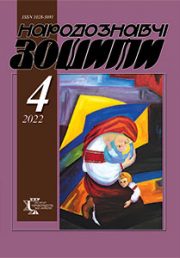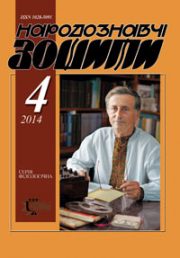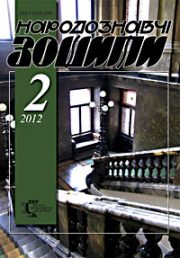The Ethnology Notebooks. 2021. # 1 (157), P. 111—118
УДК 75.077(477)”18/19″
DOI https://doi.org/10.15407/nz2021.01.111
Natalia TYMOSHENKO
- ORCID ID: https://orcid.org/0000-0001-6647-0169
- Post-graduate student of the National Academy of Fine Arts and Architecture,
- Senior Researcher,
- National Center of Folk Culture «Ivan Honchar Museum»,
- str. Lavrska, 19, 01015, Kyiv, Ukraine,
- e-mail: Nat_tim_20@ukr.net
THE PROBLEM OF THE ART TERMINOLOGY OF FOLK PAINTING OF UKRAINE OF THE LATE XIX — XX CENTURIES
Introduction. In the modern art world of Ukraine, the conceptual and categorical framework of folk painting terminology is being formed. The urgency of this issue depends on public interest, which is expressed in the folk painting popularization by means of exhibition and research activities.
Target setting. There are such issues as: unification of terms in accordance with international standards; regression of polysemic words, updating of new ones; synonymicity of definitions in application.
The goal of the research is to unify the meanings of terms for integration into the scientific and cultural Western European space, while focusing on terminology formation history and on identifying a range of related problems that are inseparable from this goal.
Methods. Historiographic analysis of recent research and publications of 1980—2020, is the main research method. In order to reveal the conditions of origin, development and transformation of the terminological system, system and genetic approach is applied. The comparative semantic method is used to establish similarities and differences in terms meanings in different countries. Terminological analysis made it possible to trace the history of terminology, clarify concepts, identify the new ones, and determine their place in the conceptual apparatus of art history theory.
Research results. The research is of practical scientific importance. Review of art history encyclopedias, publications in journals and other scientific serials in Ukraine, USA, France, Canada, Great Britain, and Russia made it possible to reveal common and different in the phrasings use. The term «primitive» turned out to be an outdated one. The definition of Traditional art corresponds to such definitions as folk art, folk painting. The definition of Naive art movement refers to amateur artists’ works painted before 1945. Art of marginals and mentally deranged people — Outsider art, Art brut. There is no such trend as Kitsch, so we can talk about the features of kitsch in folk painting, or about mass or Popular art manifestations.
Specifically Ukrainian are such terms as: Amateur art — works of artists who paint for fun in their spare time, imitating professional artists. It is applied to the art of amateurs who studied in amateur groups after 1945. Folk painting — provincial, rural easel painting that reflects the Ukrainians’ traditional worldview, customs, everyday life, and has a craft character.
Conclusion. In general, terminology is being developed in Ukraine in accordance with the standards of Western European and North American art history practice.
Keywords: Folk art, Naive art, Primitive art, Kitsch, Amateur art, Folk painting.
REFERENCES
- Nehoda, O., & Palahniuk, A. (Еd.). (2005). Hryhorii Ksonz: exhibition and publishing project UTsNK «Muzei Ivana Honchara», «Rodovid» Publishing House, Tsentru doslidzhen usnoi istorii ta kultury. Kyiv: Rodovid [in Ukrainian].
- Bilokon, S., Mozdyr, M., & Sidor, O. (2006). Ukrainian Sculpture and Icone. A History of Their Rescue. Exhibition catalog. Kyiv: Rodovid [in Ukrainian].
- (1999). Colors of Ukraine: Painting Under Glass by Anastasia Rak. Published by National Museum of Natural History. Paris [in French].
- Zabolotna, N., & Savchuk, S. (Ed.). (2013). Velyke i Velychne: All-Ukrainian inter museum project. Catalog. Kyiv: Mystetskyi Arsenal [in Ukrainian].
- (2017). Press release for the exhibition project «Chyste mystetstvo». Cultural, artistic and museum complex «Mystetskyi Arsenal». Retrieved from: https://artarsenal.in.ua/vystavka/chyste-mystetstvo/ (Last accessed 4.11.2020) [in Ukrainian].
- Shmagalo, R. (2014). Bozhyna and buzyna Ukrainian art terminology (to the problems of methodology). Obrazotvorche mystetstvo, 4 (92), 110 [in Ukrainian].
- Prokofiev, V.N. (1983). About three levels in the culture of the New and Modern times (On the problem of primitive in the visual arts). Primitive and its place in the artistic culture of the New and Modern times (Pp. 6—28). Moscow: Nauka [in Russian].
- Brodskaia, N. (2007). Naїve Art. New York. USA [in French].
- Ryleva, A. (2005). About the naive Moscow: Akademicheskii Proekt; Rossiiskii institut kulturologii [in Russian].
- Gundorova, T.G. (2008). Kitsch and literature. Travesty. Kyiv: Fact [in Ukrainian].
- Kann, J. (2014). Is naive art really so naive? 20-th — century Ukrainian Naive Art. Retrieved from: https://ukrainian-naive.com/publication/cahn_assey (Last accessed 4.11.2020) [in Ukrainian].
- Benedetti, Joan M. (2000). Words, Words, Words: Folk Art Terminology — Why It (Still) Matters. Art Documentacion, 1 (Vol. 19, pp. 14—21). The University of Chicago Press. USA.
- Vlasov, V.G. (2007). Primitive art. Primitives. New Encyclopedic Dictionary of Fine Arts: in 10 vol. (Vol. 7 (П), pp. 748—751). St. Petersburg: Azbuka-klassika [in Russian].
- (1995). Traditional folk art, professional art, primitive. Creativity on the borders of types of artistic thinking: Catalog of the exhibition dedicated of Second Honchar memorial conference. Kyiv: Ivan Honchar Museum [in Ukrainian].
- Klimenko, O. (1995). On the question of the term «primitive». Ukrainian folk art in terms of international terminology (primitive, folklore, amateurism, naive, kitsch …). Collective researches after the reports of Second Ivan Honchar memorial conference (Pp. 14—15). Kyiv: Ivan Honchar Museum [in Ukrainian].
- Primitive art. Art & Architecture Thesaurus® Online. Retrieved from:
- https://www.getty.edu/vow/AATFullDisplay?find=primitive&logic=AND¬e=&english=N&prev_page=1&subjectid=300056500/ (Last accessed 4.11.2020).
- Russell Harper, John. (2006). Folk art. The Canadian Encyklopedia. Retrieved from: http://www.thecanadianencyclopedia.ca/en/article/folk-art/ (Last accessed 4.11.2020).
- Art brut. Wikipedia. Retrieved from: https://fr.wikipedia.org/wiki/Art_brut (Last accessed 4.11.2020) [in French].
- Definition of folk art. The definitions. Retrieved from: https://lesdefinitions.fr/art-populaire (Last accessed 4.11.2020) [in French].
- Popular art. (2020). Art & Architecture Thesaurus® Online. Retrieved from: https://www.getty.edu/vow/AATFullDisplay?find=Popular+art&logic=AND¬e=&english=N&prev_page=1&subjectid=300311927 (Last accessed 4.11.2020).
- Popular art. Encyclopaedia Britannica online. Retrieved from: https://www.britannica.com/art/popular-art (Last accessed 4.11.2020).
- Self-taught artists. Art & Architecture Thesaurus® Online. Retrieved from:https://www.getty.edu/vow/AATFullDisplay?find=Self-taught+artist&logic=AND¬e=&english=N&prev_page=1&subjectid=300257252 (Last accessed 4.11.2020).
- Naive art. Art & Architecture Thesaurus® Online. Retrieved from: https://www.getty.edu/vow/AATFullDisplay?find= naive+art&logic=AND¬e=&english=N&prev_page=1&subjectid=300263555 (Last accessed 4.11.2020).
- Outsider art. Art & Architecture Thesaurus® Online. Retrieved from: https://www.getty.edu/vow/AATFullDisplay?find=outsider+art&logic=AND¬e=&english=N&prev_page=1&subjectid=300056472 (Last accessed 4.11.2020).
- Kitsch. Art & Architecture Thesaurus® Online. Retrieved from: https://www.getty.edu/vow/AATFullDisplay?find= kitsch&logic=AND¬e=&english=N&prev_page=1&subjectid=300056181 (Last accessed 4.11.2020).
- Polevoy, V.M., Markuzon, V.F., Sarabyanov, D.V., & Sinyukov, V.D. (Ed.). (1986). Amateur art. Popular art encyclopedia: Architecture. Painting. Sculpture. Graphic arts. Decorative arts (Book II, p. 214). Moscow: Soviet Encyclopedia [in Russian].
- Vlasov, V.G. (2008). Amateur art. New Encyclopedic Dictionary of Fine Arts: in 10 vol. (Vol. 8, pp. 503—504). St. Petersburg: Azbuka-klassika [in Russian].
- Karpova, L.O. (2013). Cultural and educational activities. History of Ukrainian culture (Vol. 5, book 4, pp. 216—237). Kyiv: Naukova dumka [in Ukrainian].
- Vlasov, V.G. (2010). Dilettantism. New Encyclopedic Dictionary of Fine Arts: in 10 vol. (Vol. 3, pp. 440—442). St. Petersburg: Azbuka-klassika [in Russian].







